The Secret Bee Garden: Exploring Its Unique Relationship with Flowers
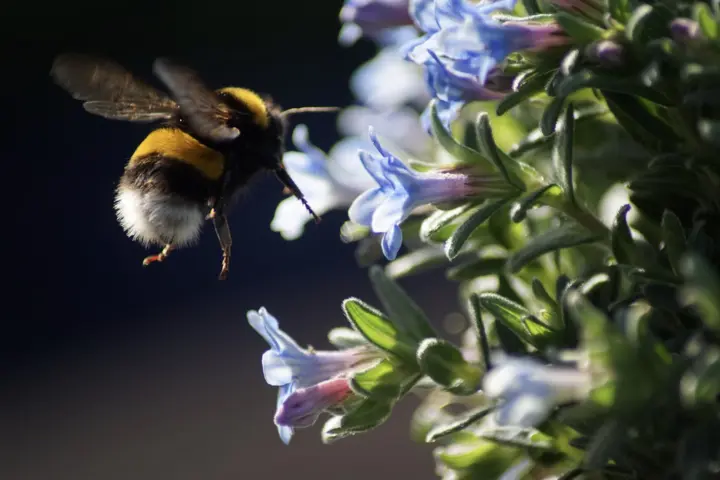
The secret bee garden is one of the wonders that nature gives us, as it embodies the unique and complementary relationship between the bee and flowers. The wonders of this garden are manifested in its magnificent and amazing harmony between plants and insects, and reflect the innate splendor of the plant and animal world. By exploring this unique relationship between the bee and flowers, we try to understand their deep harmony and their respective roles in natural life.
Show key points
- The relationship between bees and flowers is both aesthetically harmonious and biologically essential, reflecting a deep interdependence that benefits both organisms.
- Bees facilitate plant reproduction through a precise and efficient pollination process, transferring pollen from male to female flower parts during their nectar collection.
- Flowers influence bee behavior significantly through chemical signals and vibrant colors, which guide bees to appropriate nectar sources and affect their social cooperation.
- ADVERTISEMENT
- As crucial pollinators, bees support plant biodiversity by promoting genetic variation and the reproduction of countless plant species, including wild and crop plants.
- The stability of the bee-flower relationship is threatened by climate change, as rising temperatures and irregular rainfall reduce flower availability and impact bee activity.
- This natural cooperation between bees and plants exemplifies ecological balance and teaches us the importance of biodiversity, mutual benefit, and environmental respect.
- Preserving the bee-flower bond requires human responsibility and global action to mitigate climate change and protect ecosystems for future sustainability.
1. The nature of the bee's relationship with flowers.
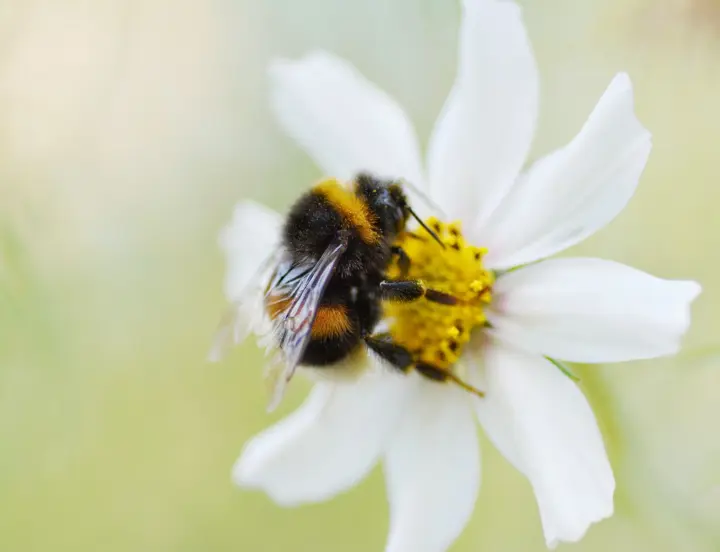
The nature of the relationship between the bee and flowers is picturesque and unique in the world of insects and plants, where the aesthetic and harmony of this relationship is manifested in a way that cannot be described in words. The bee is one of the most important organisms that play a vital role in pollinating flowers and spreading pollen, which contributes significantly to the continuity and diversity of plants.
Recommend
When a beautiful flower blooms, it becomes nutritious for the wandering bee looking for its nectar. The bright colors of the flowers harmonize with the glitter of the bee's wings, creating a charming painting. The bee begins to collect nectar and pollen from flowers, and it works tirelessly and transfers pollen from one flower to another with its structure and sudden speed.
But the relationship between the bee and the flowers is not just a research business deal, but a symbiotic relationship based on exchange and interdependence. The bee provides flowers with a valuable service when they transmit pollen and contribute to their reproduction, while flowers provide the bee with a source of food and energy through its delicious nectar. This peaceful and fruitful exchange builds on the basis of biological cooperation between animals and plants, and reflects the beauty of nature in giving and mutual benefit.
Each type of flower has a unique relationship with the bee, as the flowers develop intelligently to attract the right bee to pollinate it. Flowers send certain light and chemical signals to attract bees and show them where their nectar is. In turn, the bee recognizes these signals and goes directly to the specific flower, thus achieving the balance and harmony that makes the pollination process efficient and certain.
The nature of the relationship between the bee and the flowers reflects the beauty that life can achieve through cooperation and integration. It teaches us that diversity and diversity in nature are not a defect, but a foundation for survival and prosperity. Only in balance and cooperation between animals and plants can we obtain more beauty and splendor than our craziest dreams.
2. The mechanism of pollination of flowers by the bee.
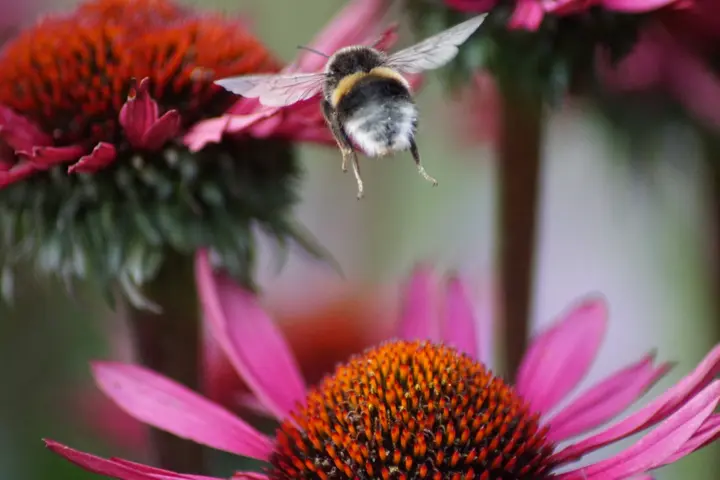
Pollination of flowers by a bee is a multifaceted biological process that allows flowers to reproduce and sexually reproduce. The bee plays a crucial role in transferring the dust that carries pollen from the male flowers to their females, allowing them to fertilize and produce seeds that will envelop new generations of plants. In this context, the effect and necessity of the bee as a pollination medium for plants is manifested, as the bee performs a set of procedures and techniques to facilitate this vital process.
When the bee approaches the flower, the process begins with a severe sensitivity that pushes it to transfer the dust on its body, which carries pollen, to the neighboring flower. This process depends on the friction of the plant parts with the body of the bee, especially its wings and hairline scalp, where the flowers are pollinated by the transfer of dust from the female of the flower to the bee's down. Thus, the bee moves pollen from plant to plant, and from those active flowers to other flowers looking for an opportunity to pollinate.
Interestingly, the bee is not just a random medium that transports pollen without dispersion, it organizes the pollination process in smart and efficient ways. When a bee feeds on flower nectar, it often attaches to the reproductive parts of the flower, ensuring that pollen bears on its body. When a bee moves to another flower, the pollen is transmitted from the bee's body to the female flower through random transmission or in the designated order. This mechanism found in the bee's body is part of its routine and natural movements, but contributes to the efficient and orderly transport of pollen.
Over time, the bee has evolved into an effective and intelligent way to transport pollen and contribute to plant spread and diversity. Understanding the mechanism of pollination of flowers by the bee helps us appreciate the importance of this insect and preserve its environment to ensure the continuity of this balance and its natural beauty.
3. The effect of flowers on the behavior of the bee.
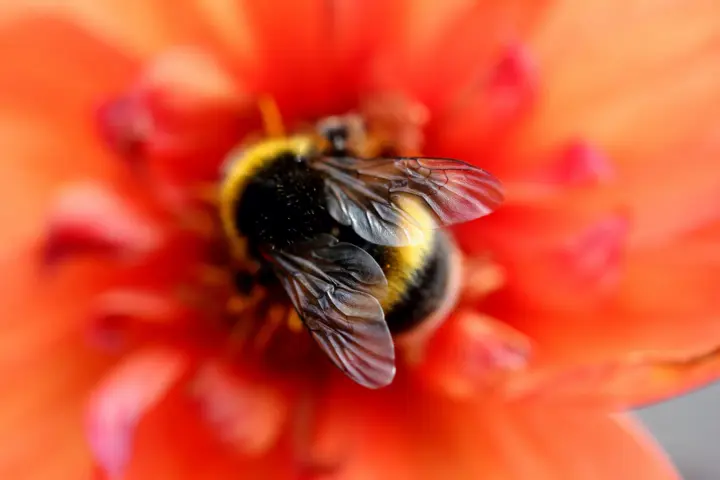
The bee is one of the delicate and beautiful insects that live in the world of flowers, as it relies on flower nectar as the main source of food and works to pollinate flowers with their pollen lining. However, flowers are not only a source of food for the bee, but also have a profound impact on its behavior and safety.
One of the main known about the relationship of the bee to flowers is the presence of chemical compatibility between the smells emitted by the flowers and the sensitive olfactory sense of the bee. When a bee approaches a particular flower, it senses certain odors emanating from the flower, and these smells play a crucial role in determining the behavior of the bee and directing it to the desired flower. Smells send complex signals to the bee, telling it there is nectar and directing it towards the food source.
But these are not the only ways in which flowers affect the behavior of a bee. The colors of flowers can also affect their behavior, as bees are a powerful visual animal and sensitive to colors. Flowers that emit bright, attractive colors tend to attract bees towards them more, and may be a motivating factor for them to collect nectar from these flowers more effectively and actively. Thus, colors can motivate the bee to perform its role in pollination better and more effectively.
In addition, flowers can also affect the social behavior of bees, when brightly colored and pleasantly smelling flowers are abundant, the bees work more organized and collaboratively in the group. Similarly, when food sources are few or limited, bees become more anxious and can compete with each other for food, affecting overall group dynamics.
In short, flowers are not just a source of food for bees, they have a significant impact on their behavior and life in general. The harmony of scents and colors and the chemical compatibility between flowers and bees form a complex and beautiful system that embodies the splendor and harmony that occurs in our natural world.
4. The vital role of the bee in promoting plant diversity.
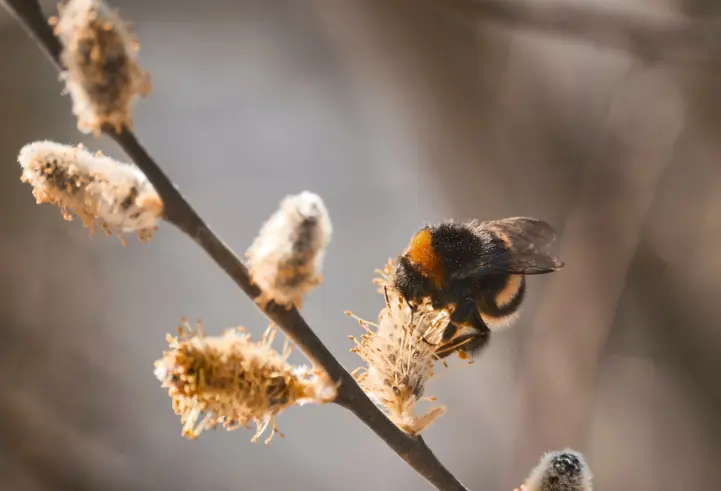
The bee is one of the most important organisms in promoting plant diversity on earth. We cannot ignore their vital role in the pollination, fruiting and reproduction of flowers. The developed and interrelationship between plants and bees contributes to the continuity of plants and stimulates their growth and development. It's an amazing relationship that deserves study and appreciation.
The bee is an intermediary between flowers and the transfer of pollen between them, which contributes to the pollination of flowers and seed production. This is essential in shaping and preserving plant diversity. The bee attaches to the pollen seed and transfers it from flower to flower, in this way, ensures genetic separation and transfer of plant genetic diversity. The transmission of pollen by the bee has a positive and tangible effect on the growth and quality of plants.
In addition, the bee stimulates the growth of plants and provides them with the right environment for them to reproduce. When a bee moves between flowers, it moves nutrients from one flower to another. This leads to improved soil quality and nutrition of plants with essential elements that help in their growth and flowering. The bee acts as a regulator of agricultural production and ensures healthy plant growth and strong diversity of ecology.
It is also known that the bee plays an important role in pollinating wild plants and fruit trees. They help increase crop yield and improve fruit quality. This is of great economic importance in terms of providing food to humanity and enhancing food security. The continuity of the bee and its abundant presence in the ecosystem strengthens plant diversity and protects plants from extinction.
Hence, it can be said that there is a wonderful and necessary cooperative relationship between plants and bees. It is a renewed and evolving relationship between each party that promotes environmental sustainability and the beauty of nature. Therefore, we must take care of and protect bees and provide them with a suitable environment for them to work and thrive. We rely on bees to achieve ecological balance and healthy lives for plants and humans alike.
5. The impact of climate change on the bee's relationship with flowers.
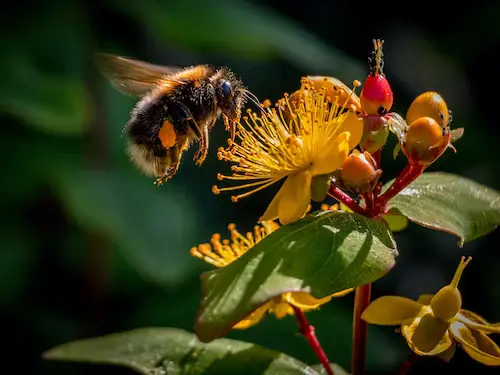
The bee is a beneficial atmospheric insect that plays a vital role in the process of pollinating flowers and stimulating plant growth. However, climate change poses a major threat to this unique relationship between bees and flowers. Through climate change, both bees and plants are exposed to numerous risks, causing a negative impact on the beautiful and complex relationship that unites them.
Rising temperatures caused by climate change is one of the most important challenges faced by bees and flowers. When the temperature rises excessively, the bee may be negatively affected and become heat stressed, affecting its ability to work and pollinate. In addition, high temperatures are caused by the phenomenon of rapid development of flowers and the early end of their flowering period, which makes them unable to provide the necessary food for the bee.
Moreover, climate change is having significant impacts on rainfall distribution and plant growth. In areas with increasing drought, bees are faced with the scarcity and diminishing diversity of flowers, which affects the availability of bee nutrition sources and puts them at risk of hunger and nutritional deficiencies. In addition, flowers may be directly affected by water scarcity and moisture, making them unable to grow and bloom properly, leading to a lack of pollination and reproduction of plants.
Given these great challenges faced by bees and flowers due to climate change, maintaining this unique and vital relationship requires joint efforts from the global community. Governments and environmental organizations must adopt strategies to combat climate change and protect biodiversity, leading to a sustainable environment that supports plant growth, enhances bee presence and allows this beautiful and essential relationship between them to continue.
We must realize that protecting bees and flowers is not just an environmental issue, but a humanitarian issue that concerns our future and the fate of this planet. Caring for the interconnected relationship between bees and flowers reflects our ability to maintain the balance of nature and preserve biodiversity that contributes to the sustainability of our lives and the lives of future generations. We must work together to prevent the exacerbation of climate change and protect this natural miracle shaped by the bee's relationship with flowers.
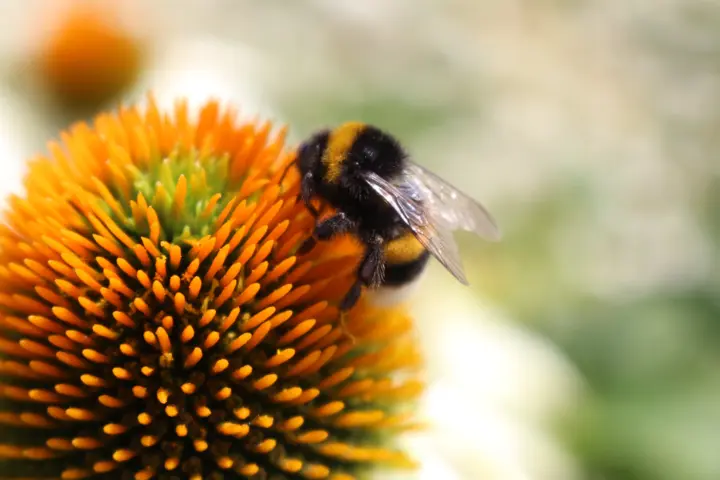
The secret bee garden shows us the beauty and splendor of nature, and reminds us of the harmony and integration that takes place within our natural world. It teaches us that every part of nature has its own role and that everything is unimaginably interconnected and interrelated. Therefore, we must maintain this fragile balance and coexist with the environment in order to continue these natural wonders.








